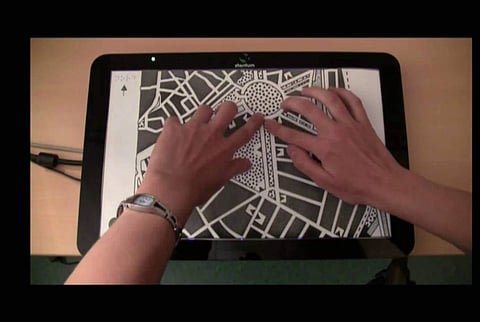

Even before they learn the alphabet, children begin to comprehend colours and images — pictures are often the child's first glimpse into the world. However, it's not the same for visually impaired children who often have to wait until they start to learn Braille. But not being able to comprehend pictures also means that visually impaired children cannot aspire to study subjects like science, math and geography.
Ankita Gulati, an IIT-Delhi student has managed to create a product that makes it possible for students to interpret pictures and maps through tactile diagrams along with audio! 'TouchVision' is custom-made for the Indian audience, meaning that it also works in regional languages and it comes at a much much lower cost, making it accessible for people from all sections of society.
When it came to doing her Masters project, Ankita approached her mentor and spoke about her intention to come up with a solution for an issue that the differently-able might be facing. "My mentor asked me to go and visit places that shelter the differently-abled — from homes to orphanages to schools. So I visited them and started to learn the different ways in which they might be falling short. I would speak and discuss with the teachers and students to get their perspectives. I did this research for six months," she explained. On one of her visits, Ankita noticed a teacher trying to teach the students the world map. The map was handmade with pulses and other material to differentiate the texture. The students were supposed to learn through touch about the different continents but they were struggling to comprehend. That's when Ankita found the real world problem she was looking for to solve.
______________________________
______________________________
After the session, she asked teachers several questions about graphics accessibility and how math and science diagrams are taught. Teachers listed out various challenges and explained that students are taught using handmade diagrams in special schools and once they are integrated into inclusive schools, the diagrams are excluded from the curriculum.
Watch the video for a better understand of the working of the device-
Ankita decided that tactile diagrams accompanied with audio is what would work best for the students, “Our solution is an affordable multimodal inclusive education platform for visually impaired people comprising of tactile diagrams assisted by simultaneous audio clips powered by the mobile app. The app works in two modes — online and offline, and allows cloud sourcing of data in online mode, " she explained.
It took three years for Ankita to create this platform for students but it is obviously worth all the sweat."We had so many trials that students started to ask us when we would eventually be able to launch this. That itself makes me feel so good because they were so impatient to start using it. That was our eureka moment," she said with a smile. The team was recently nominated for the Design: Impact Awards, by Titan, in collaboration with Tata Trusts which identifies, celebrates and supports innovative product designs that cause social change.
Besides Math, Science and Geography books, Ankita's company works with storybooks too. "We're also working on books written in native languages, different kinds of storybooks, Champak and other popular series. But another thing that is a challenge for us is that not all children have a standard level of impairment, there is a range and we have to try and cater to all of them. Some children can see a few colours so we try and make the pictures bright coloured," she explained.
Presently, the company is putting together its own content development team, "We're also trying to branch out into the gaming genre. In the next one year we hope that our books will be read by at least half the states in the country," the young entrepreneur said. Ankita says that she wasn't someone who was content with her regular work and aspired to be part of a social change. "I've always nursed an urge to solve a real-world problem. I didn't think that I would eventually be working with something related to disability but I'm happy I've been able to work in this area," she said.
